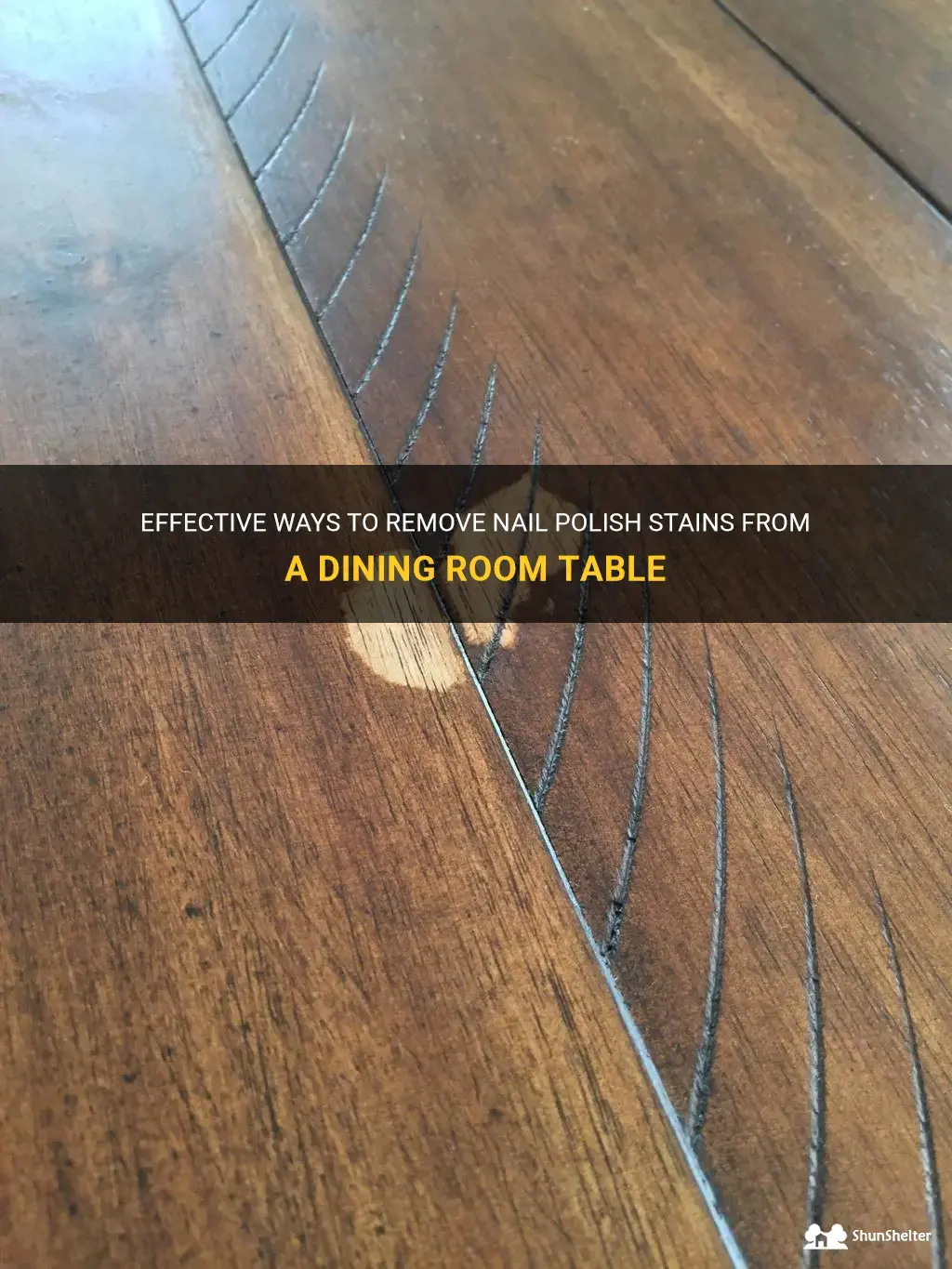
Are you tired of seeing those stubborn nail polish stains on your dining room table? Don't worry, we've got you covered! Whether you accidentally spilled nail polish or your little one got creative with their artwork, getting nail polish off your table might seem like a daunting task. But fear not, with the right techniques and a little bit of patience, you can make your table look as good as new in no time. So, grab your polishing skills and let's dive right into our guide on how to get nail polish off your dining room table!
What You'll Learn
- What is the best method for removing nail polish from a dining room table?
- Are there any specific products or household items that work well for removing nail polish stains from a dining room table?
- How can I prevent any damage or discoloration to the surface of my dining room table while removing nail polish?
- Are there any alternative methods or natural remedies for removing nail polish from a dining room table?
- Should I consult a professional or consider refinishing my table if the nail polish stain is stubborn and won't come off using common methods?

What is the best method for removing nail polish from a dining room table?
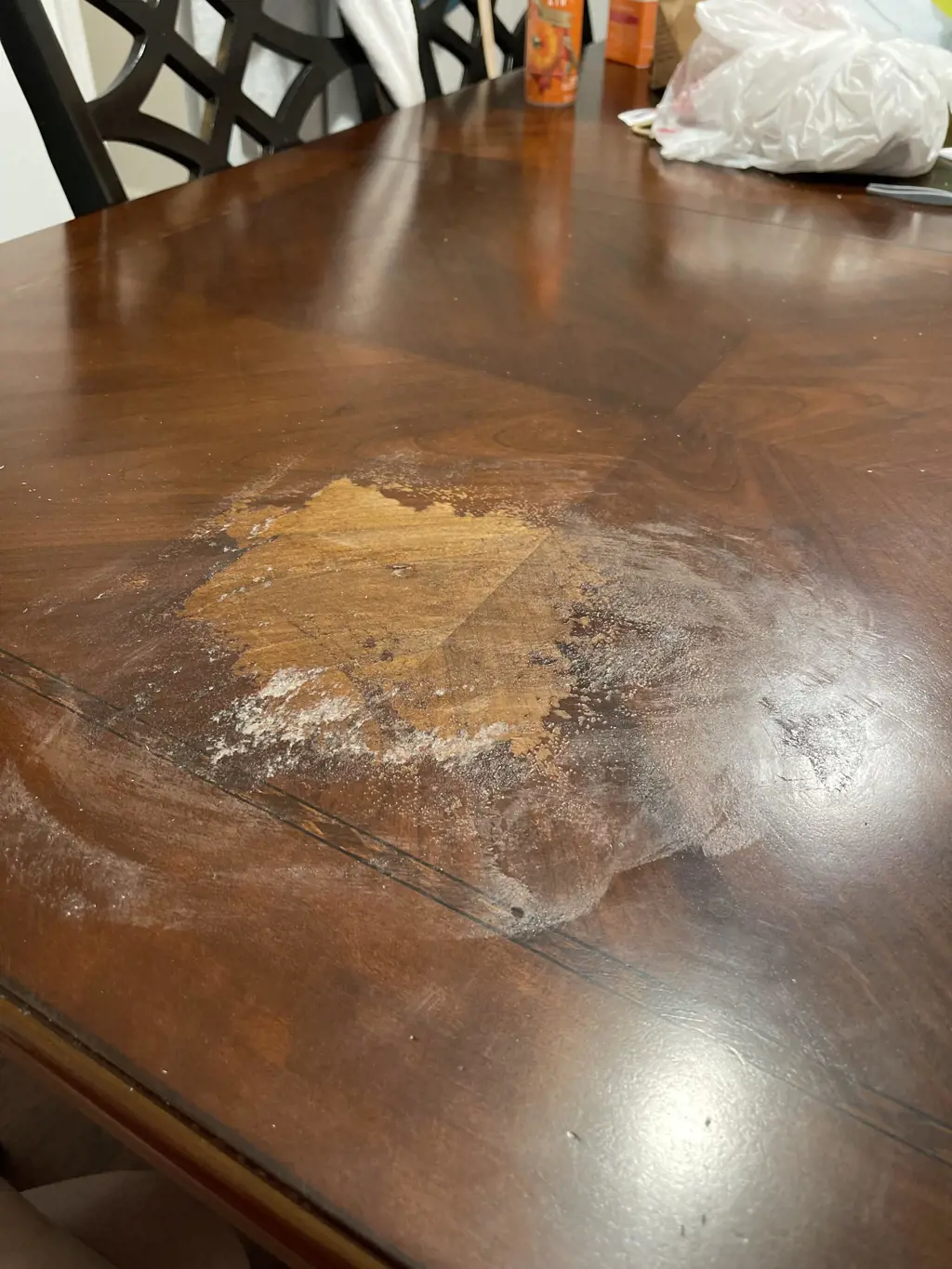
When it comes to removing nail polish from a dining room table, you'll want to be careful to avoid damaging the surface of the table. Here is a step-by-step guide on the best method for removing nail polish from a dining room table.
Step 1: Act quickly
As soon as you notice the nail polish spill on your dining room table, it's important to act quickly to prevent it from hardening and setting into the surface. The longer the nail polish sits on the table, the more difficult it will be to remove.
Step 2: Test a small area
Before attempting to remove the nail polish, test a small, inconspicuous area of the table to make sure the removal method you choose does not damage the finish. Apply a small amount of nail polish remover or other cleaning agent to a cloth and gently rub it on a small area. If there is no negative reaction, proceed with the rest of the table.
Step 3: Use an acetone-based nail polish remover
An acetone-based nail polish remover is one of the most effective ways to remove nail polish from a dining room table. Moisten a cloth with the nail polish remover and gently dab it onto the nail polish stain. Be careful not to rub too hard, as this may damage the table finish.
Step 4: Blot, don't rub
Rather than rubbing the nail polish stain, it's best to blot it gently. Rubbing can spread the stain and push it further into the table. Blotting helps lift the nail polish off the table without causing additional damage.
Step 5: Repeat if necessary
If the nail polish stain is not completely removed with the first attempt, repeat the process until it is no longer visible. Be patient and persistent, as it may take multiple attempts to fully remove the stain.
Step 6: Clean and condition the table
Once the nail polish has been successfully removed, it's important to clean and condition the table to keep it in good condition. Wipe the entire table with a mild detergent and warm water solution to remove any residue from the nail polish remover. Then, apply a furniture polish or conditioner to restore the shine and protect the table's finish.
Example:
Sarah, a homeowner, experienced a nail polish spill on her dining room table during a girls' night in. Panicked, she quickly searched for the best method to remove nail polish from a dining room table. Following the step-by-step guide, Sarah acted quickly, testing a small area of the table to ensure no damage would occur. Once she confirmed that the nail polish remover did not affect the finish, she proceeded to gently blot the stain with an acetone-based nail polish remover. After a few repetitions, the stain was completely removed, leaving Sarah relieved. She then cleaned the table with a mild detergent and warm water solution, and applied a furniture polish to keep the table looking its best. Sarah learned that with a little patience and the right technique, removing nail polish from a dining room table is possible without causing damage.
The Spacious Elegance of a Kitchen Dining Room: Exploring Size and Design
You may want to see also

Are there any specific products or household items that work well for removing nail polish stains from a dining room table?
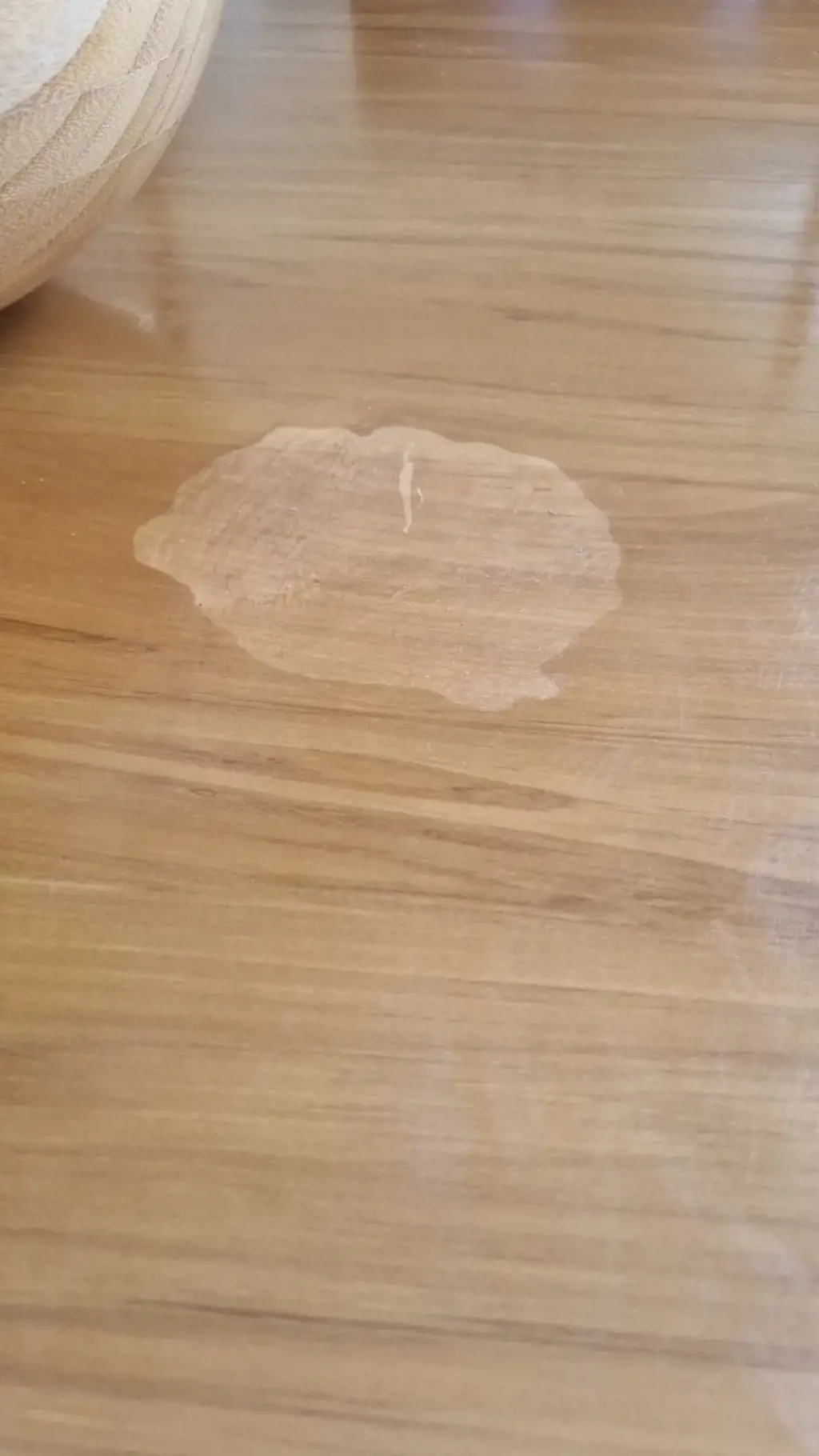
Nail polish stains can be a frustrating and unsightly mess, especially when they end up on your dining room table. However, with the right products and techniques, you can effectively remove these stains and restore the beauty of your table. In this article, we will discuss some specific products and household items that work well for removing nail polish stains from a dining room table.
- Acetone or nail polish remover: Acetone is a powerful solvent that is commonly found in nail polish removers. It is highly effective in breaking down nail polish and removing it from surfaces. To use acetone or nail polish remover, simply dampen a clean cloth or cotton ball with the solution and gently rub the stain in a circular motion. Be sure to test the solution on a small, inconspicuous area of the table first to avoid any potential damage.
- Rubbing alcohol: Rubbing alcohol is another effective option for removing nail polish stains. It works by dissolving the nail polish and breaking it down for easy removal. To use rubbing alcohol, dampen a clean cloth or cotton ball with the alcohol and gently rub the stain in a circular motion. Again, it is important to test the solution on a small area of the table before applying it to the stain.
- Baking soda: Baking soda is a versatile household item that can be used for a variety of cleaning purposes, including removing nail polish stains. To use baking soda, create a paste by mixing it with a small amount of water. Apply the paste to the stain and gently rub it in using a clean cloth or sponge. Allow the paste to sit for a few minutes before wiping it away with a damp cloth. This method may require some additional scrubbing for stubborn stains.
- Hairspray: Hairspray is a surprising but effective solution for removing nail polish stains from a dining room table. This is because hairspray often contains alcohol, which can act as a solvent for the nail polish. To use hairspray, spray a small amount directly onto the stain and gently blot it with a clean cloth or paper towel. Repeat this process until the stain is completely removed.
- Hydrogen peroxide: Hydrogen peroxide is a mild bleaching agent that can be used to remove nail polish stains from a table. To use hydrogen peroxide, apply a small amount directly to the stain and gently rub it in using a clean cloth or sponge. Allow the hydrogen peroxide to sit for several minutes before wiping it away with a damp cloth. This method may lighten the color of the table slightly, so be sure to test it on a small area first.
It is important to keep in mind that different types of tables may react differently to these cleaning methods. Always test a small, inconspicuous area of your table before applying any solution to the stain. Additionally, it is important to blot and gently rub the stain rather than scrubbing aggressively, as this can damage the surface of the table.
In conclusion, nail polish stains on a dining room table can be effectively removed using a variety of products and household items. Acetone or nail polish remover, rubbing alcohol, baking soda, hairspray, and hydrogen peroxide are all effective options. Remember to test the solution on a small area of the table first and to gently blot and rub the stain for best results. With a little patience and the right approach, you can successfully remove nail polish stains and restore the beauty of your dining room table.
Uncover the Best Dining Room Tables at Kohl's and Transform Your Space
You may want to see also

How can I prevent any damage or discoloration to the surface of my dining room table while removing nail polish?
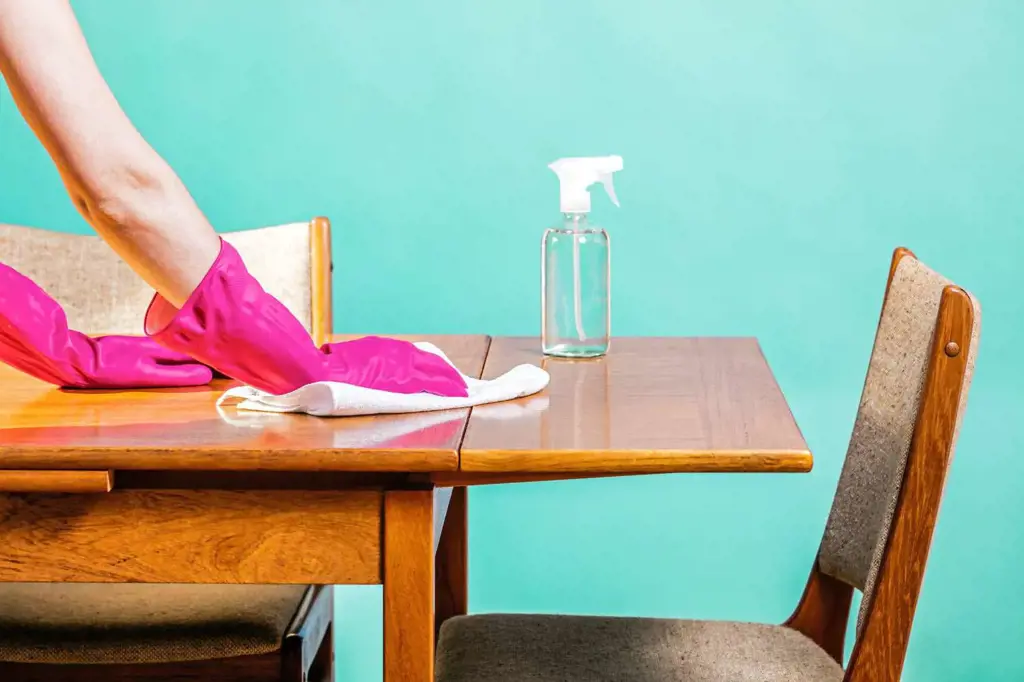
How to Remove Nail Polish from a Dining Room Table without Damaging the Surface
Accidents happen, and sometimes nail polish ends up on surfaces that we don't want it to be on, such as a dining room table. The good news is that you can remove nail polish from a table surface without causing any damage or discoloration. Just follow these step-by-step instructions and you'll have your table looking as good as new in no time.
Step 1: Act Quickly
The key to preventing damage or discoloration is to act quickly. As soon as you notice the nail polish on your dining room table, grab a cloth or paper towel and gently blot the area to remove as much of the nail polish as possible. Do not rub, as this can spread the nail polish and make the situation worse.
Step 2: Use an Acetone-Free Nail Polish Remover
To remove the remaining nail polish, use an acetone-free nail polish remover. Acetone can be harsh and may damage the surface of your table. Moisten a cotton ball or pad with the nail polish remover and gently dab it onto the nail polish. Be careful not to soak the table surface, as excessive moisture can cause damage.
Step 3: Blot, Don't Rub
Just like in step one, gently blot the nail polish remover onto the table surface. Do not rub, as this can spread the nail polish and potentially damage the finish of your table. Repeat this process until all of the nail polish has been removed.
Step 4: Clean and Dry
Once all of the nail polish has been removed, clean the table surface with a mild, non-abrasive soap and water solution. Gently scrub the area with a soft cloth or sponge to remove any residue from the nail polish remover.
After cleaning, thoroughly dry the table surface with a soft, dry cloth. Leaving excess moisture on the table can lead to damage or discoloration, so it's important to make sure it's completely dry.
Step 5: Apply Furniture Polish
To restore the shine and protect the finish of your dining room table, apply a furniture polish specifically designed for the type of finish on your table. Follow the instructions on the polish container for the best results.
Examples of preventing damage or discoloration:
- Example 1: Sarah accidentally spilled red nail polish on her dining room table. She quickly grabbed a cloth and blotted the nail polish to remove as much as she could. She then used an acetone-free nail polish remover to gently dab at the remaining nail polish, being careful not to soak the table surface. Sarah repeated this process until all of the nail polish was gone. She then cleaned and dried the table surface, and finished off by applying a furniture polish to restore the shine. Her table looked as good as new, with no damage or discoloration.
- Example 2: John noticed that his daughter had spilled nail polish remover on their dining room table. Worried about potential damage, he immediately grabbed a cloth and blotted the area to remove as much of the nail polish remover as possible. He then followed the same steps as Sarah, using an acetone-free nail polish remover to remove the remaining residue. John was careful not to rub or spread the nail polish remover, and made sure to clean and dry the table surface thoroughly. He finished off by applying a furniture polish to protect the finish of his table. Thanks to his quick actions and proper technique, there was no damage or discoloration to their dining room table.
Remember, prevention is better than a cure. To avoid accidents like these, always make sure to protect your dining room table with a tablecloth or placemats when doing any activities that involve nail polish. But if an accident does happen, just follow these steps, and you'll be able to remove nail polish from your table without causing any damage or discoloration.
Designing and Creating a Custom Booth for Your Dining Room
You may want to see also

Are there any alternative methods or natural remedies for removing nail polish from a dining room table?
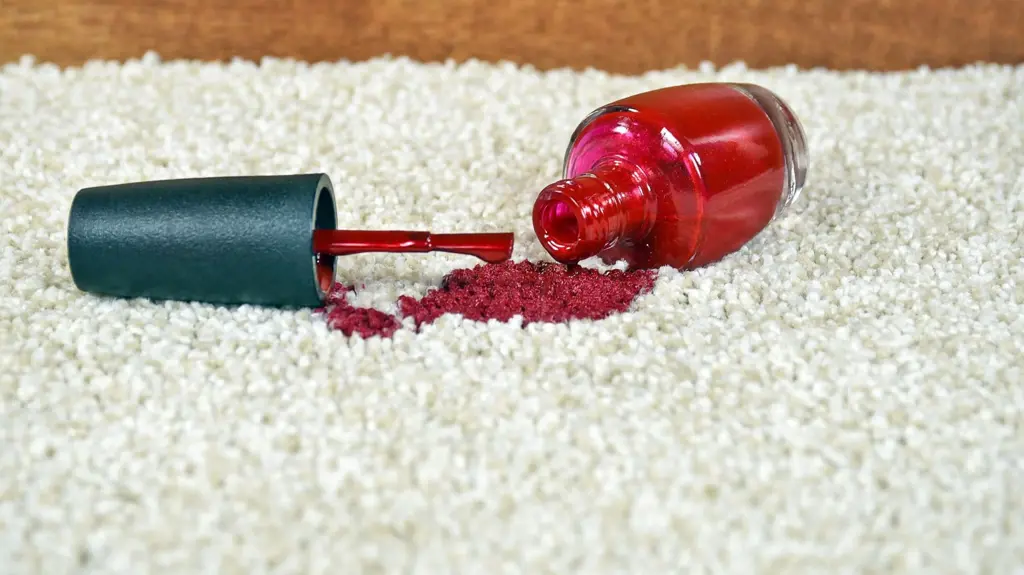
Nail polish can be a stubborn stain to remove, especially from a delicate surface like a dining room table. While there are many commercial nail polish removers on the market, these can often contain harsh chemicals that can damage the table's finish. Fortunately, there are alternative methods and natural remedies that can effectively remove nail polish without causing any harm.
One natural remedy for removing nail polish from a dining room table is using rubbing alcohol. This method is safe for most types of finishes, including wood, laminate, and glass. To use this method, start by blotting the excess nail polish with a clean cloth or paper towel. Then, wet a cotton ball or cotton swab with rubbing alcohol and gently dab it onto the nail polish stain. Continue to dab, rather than rub, until the stain lifts. For tougher stains, you may need to repeat this process multiple times. Once the stain is removed, wipe down the area with a damp cloth to remove any residue. Finally, dry the table thoroughly to prevent any water damage.
Another natural remedy that can be used to remove nail polish from a dining room table is using vinegar. Vinegar is known for its cleaning properties and can be an effective nail polish remover as well. To use this method, mix equal parts vinegar and warm water in a bowl. Dip a cloth or sponge into the solution and gently dab it onto the nail polish stain. Allow the vinegar solution to sit on the stain for a few minutes to loosen the polish. Then, gently scrub the stain with the cloth or sponge until the polish lifts. Rinse the area with clean water to remove any residue and dry the table thoroughly.
In addition to these natural remedies, there are also alternative methods that can be used to remove nail polish from a dining room table. One method is using non-acetone nail polish remover, which is a milder alternative to regular nail polish remover. Non-acetone nail polish removers are less harsh on surfaces and can be found at most drugstores. Simply apply a small amount of non-acetone nail polish remover to a clean cloth or cotton ball and gently dab it onto the stain. Continue to dab until the stain is removed, and then wipe down the area with a damp cloth to remove any residue.
If you prefer not to use any chemicals or natural remedies, another alternative method for removing nail polish from a dining room table is using heat. This method works best for hard surfaces like glass or metal. To use this method, start by heating the nail polish with a hairdryer on a low setting for a few seconds. Then, use a credit card or plastic scraper to gently scrape off the softened nail polish. Be careful not to apply too much pressure to avoid scratching the surface. Once the majority of the nail polish is removed, use a cloth or sponge soaked in warm soapy water to clean off any residue.
In conclusion, there are several alternative methods and natural remedies that can be used to remove nail polish from a dining room table. These methods include using rubbing alcohol, vinegar, non-acetone nail polish remover, and heat. It is important to be gentle when applying these methods to avoid damaging the table's finish. Always test any method on a small, inconspicuous area before applying it to the entire stain. With a little patience and persistence, you can effectively remove nail polish stains from your dining room table using these alternative and natural methods.
Creative Ways to Decorate the Pass-Through Between Your Kitchen and Dining Room
You may want to see also

Should I consult a professional or consider refinishing my table if the nail polish stain is stubborn and won't come off using common methods?
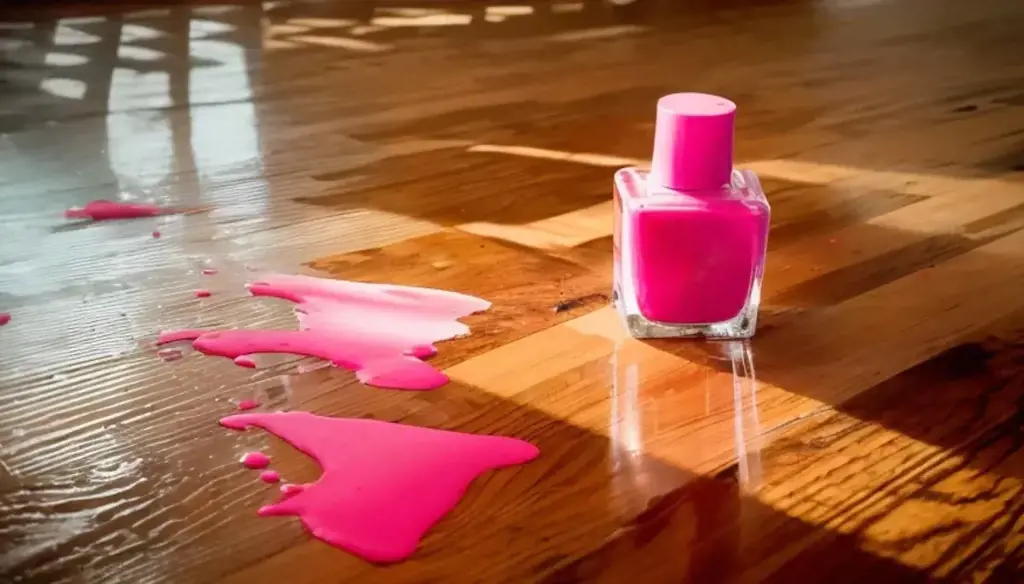
If you have a stubborn nail polish stain on your table that won't come off using common methods, it may be time to consider consulting a professional or taking the refinishing route. Nail polish can be a tough stain to remove, especially if it has set into the surface of the table. In this article, we will discuss when it is appropriate to seek professional help or refinish your table, and the steps involved in each process.
When determining whether to consult a professional or refinish your table, there are a few factors to consider. First, assess the severity of the stain. If it is a small and superficial stain, you may be able to remove it yourself using common household items like nail polish remover or rubbing alcohol. However, if the stain is large, deeply embedded, or has been on the table for a long time, it may require more intensive treatment.
Next, consider the type of table material you are working with. Different materials may require different methods of stain removal or refinishing. For example, a solid wood table may need to be sanded and refinished, while a laminate table may just need a deep cleaning or a new top coat. It is important to research the specific requirements for your table material before proceeding.
If the stain is stubborn and traditional methods are not effective, it is advisable to consult a professional. A furniture restoration expert or a professional cleaner will have the knowledge and experience to deal with tough stains without causing further damage to your table. They may have access to specialized tools and products that are not readily available to the average homeowner.
Alternatively, you can consider refinishing your table if the stain cannot be removed and you are willing to invest the time and effort into restoring its appearance. Refinishing a table involves sanding down the surface to remove the existing finish, treating any stains or scratches, and applying a new finish to restore its original look. It can be a challenging process, but with patience and the right tools, it can be a rewarding DIY project.
Here are the step-by-step instructions for refinishing a table:
- Prepare the workspace: Choose a well-ventilated area with ample space to work. Lay down drop cloths or newspapers to protect the surrounding area from dust and debris.
- Remove the existing finish: Use a chemical stripper or sandpaper to remove the existing finish from the table. Follow the instructions on the product you are using and take care to work in small sections, moving with the grain of the wood.
- Treat any stains or scratches: If there are any remaining stains or scratches on the table, use appropriate products to treat them. This may involve using a wood bleach for dark stains or filling in scratches with wood filler.
- Sand the surface: Use progressively finer grit sandpaper to smooth the surface of the table. Start with a coarse grit and work your way up to a finer grit. This will create a smooth and even surface for the new finish.
- Apply the new finish: Choose a finish that suits your table material and desired look. This can be a stain, varnish, or paint. Apply the finish according to the manufacturer's instructions, using a brush or a cloth. Allow each coat to dry fully before applying the next.
- Seal the finish: Once you are satisfied with the appearance of the table, apply a protective sealant to prevent future damage. This can be a clear varnish or polyurethane coating.
By following these steps, you can refinish your table and restore it to its former glory. However, if you are unsure about any part of the process or have a valuable or sentimental piece of furniture, it is always best to consult a professional to ensure the best results.
In conclusion, a stubborn nail polish stain on your table may require professional help or refinishing. Assess the severity of the stain and the material of your table to determine the best course of action. If traditional stain removal methods fail, consult a professional for their expertise and access to specialized tools. Alternatively, you can refinish your table by following the appropriate steps, but be prepared for a time-consuming and challenging process. Remember to research and follow the specific requirements for your table material to achieve the best results.
The Importance of Spindles Between Legs: How They Provide Support for Dining Room Chairs
You may want to see also
Frequently asked questions
To remove nail polish from a dining room table, start by gently wiping away any excess polish with a dry paper towel or cloth. Then, dampen a cotton ball or soft cloth with nail polish remover or rubbing alcohol. Blot the stained area, being careful not to rub or scrub, as this may damage the table's finish. Continue blotting until the nail polish is lifted from the surface. Finally, rinse the area with mild soap and water, and dry with a soft cloth.
Nail polish remover or rubbing alcohol can potentially damage the finish of a dining room table if used improperly or if the table has a delicate or sensitive finish. It is important to test the nail polish remover or rubbing alcohol on a small, inconspicuous area of the table first to ensure it does not cause any discoloration or damage. If the finish appears to be sensitive, it may be better to consult a professional for advice on how to remove the nail polish safely.
Yes, non-acetone nail polish remover can be used to remove nail polish from a dining room table. Non-acetone nail polish remover is generally milder and less likely to damage the table's finish compared to acetone-based removers. However, it may take a bit more time and effort to fully remove the nail polish using non-acetone remover. Follow the same steps as mentioned earlier, and be sure to test a small area of the table first to ensure there is no adverse reaction.
If nail polish remover or rubbing alcohol is not available, there are other household items that can potentially remove nail polish from a dining room table. You can try using a mixture of baking soda and water to create a paste, which can be applied to the stained area. Gently rub the paste onto the stain using a soft cloth or sponge, and rinse with mild soap and water. You can also try using vinegar or lemon juice as a natural alternative to remove the nail polish, following a similar process.
To prevent nail polish stains on your dining room table, it is important to take precautions when doing nail care activities near the table. Always place a protective barrier, such as a towel or newspaper, underneath your nails to catch any drips or spills. If a spill does occur, quickly wipe away any excess polish with a paper towel or cloth before it has a chance to set. Regularly clean and maintain the table's surface with gentle cleaners or furniture polish to help protect the finish from potential stains.







